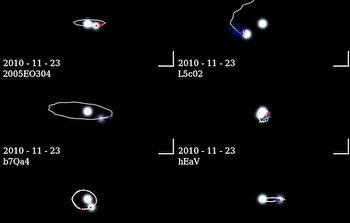Trans-Neptunian Binaries and the History of the Outer Solar System
August 22, 2011

An international team of astronomers, using data from the Gemini North telescope, are revealing the history of the outer Solar System by measuring the mutual orbits of extremely widely separated binaries located beyond Neptune in the icy Kuiper Belt. The researchers conclude that these “trans-Neptunian binaries” formed close to their current locations, and—contrary to previous suggestions—that they may have formed from direct collapse in the disk of material that produced the planets and other solid bodies of the Solar System.
Binary systems are found in most minor planet populations, such as asteroids, but binaries in the Kuiper Belt are notable due to the frequency of very widely-separated systems and those with nearly equal-sized primary and secondary bodies. A team of researchers led by Alex Parker (Harvard-Smithsonian Center for Astrophysics; formerly of the University of Victoria, Canada) followed some of the most widely-separated Kuiper Belt binaries known, using a combination of archival and new data from the Magellan Telescope, the Very Large Telescope and Gemini North telescope (geminiann11012a, animation).
Over four semesters at Gemini North, the team acquired high-resolution optical images of these systems with the Gemini Multi-Object Spectrograph in its imaging mode (geminiann11012b). The program required extremely good resolution, only possible under very stable atmospheric conditions (which astronomers call good “seeing”). With the short exposure times feasible given Gemini’s light-gathering capacity and the flexibility of queue scheduling, the observations could be obtained in the strict conditions they required. The data enabled high-precision measurement of the relative positions of the binary components without the use of adaptive optics or space-based imaging. The level of precision achieved was comparable to measuring the width of a human hair from over a kilometer away.
The team determined the properties of the mutual orbits of these binary systems for the first time, and several systems set new records. For example: 2001 QW322 is the most widely-separated binary minor planet known, with an average separation exceeding 100,000 kilometers. Another extreme is 2006 CH69, which has the most eccentric (highly elliptical) mutual orbit known—at e=0.9 the two components of this system are separated by only approximately 2,800 kilometers at closest approach, while at their most distant they have over 52,000 kilometers between them. The smallest object in the sample, 2000 CF105, has the lowest mass of any measured Kuiper Belt object—roughly twice as massive as Mauna Kea, the long-dormant volcano that is the site of Gemini North.
Their wide separations make these systems very sensitive to perturbations; encounters with massive objects like the giant planets or direct collisions with very small impactors can disrupt the binaries and send their components into solitary orbits around the Sun. Their continued existence suggests that these objects formed near their current locations in the outer Solar System and were not subject to significant migration, as some hypotheses of the origin of the Kuiper Belt have suggested. Additionally, the current Kuiper Belt cannot have a very large population of small objects since collisions would have blown apart these systems long ago.
The full study revealed further surprises about the binaries’ formation history. Unlike more tightly-bound Kuiper Belt binaries, the widely-separated systems appear to prefer low mutual inclinations, with orbital planes that are nearly aligned with the rest of the Solar System. Interestingly, about half of the systems orbit each other in the same direction as they orbit the Sun (prograde), while the other half orbit each other in the opposite sense (retrograde). Previous formation theories hold that if the binaries have low mutual inclinations, they must have formed through a pathway that tends to create only retrograde systems. The researchers suggest that the fact that these binaries have equal numbers of prograde and retrograde systems, yet also prefer low mutual inclinations, may indicate that a novel, recently-proposed formation process was at play. In this scenario, instead of building solitary Kuiper Belt objects through slow "hierarchical" accretion and then combining into binaries later, the binaries may have formed from rapid, direct collapse of solids in the protoplanetary disk.
Links
- The complete work will appear in The Astrophysical Journal, and a preprint is available now.

